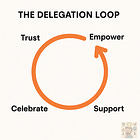From Water Tanks to Workflows: What School Maths Taught Me About Engineering Leadership
Turning textbook logic into team dynamics
TL;DR
Those old school mensuration problems, you know, bees pollinating flowers, leaky tanks filling up weren’t just about formulas. They were early lessons in systems thinking.
Fast forward to today, and the same ideas apply to engineering leadership: capacity, coverage, flow, and efficiency. Geometry wasn’t just about shapes; it was about building structures that work in life and in teams.
How It Started
Recently, my cousin’s son asked me to help him with a mensuration problem from his school textbook. As we worked through it together, memories of my own school maths came rushing back.
What started as a simple tutoring moment turned into a deeper reflection:
These were the earliest seeds of systems thinking, and strangely enough, the same concepts now show up in how I lead engineering teams.
This blog evolved from that interaction, a trip down memory lane, reconnecting with school maths, and linking it with the world of engineering leadership.
Math Class Flashback: What is Mensuration?
If you studied in the Indian education system, you’ll remember “mensuration”, the math unit where we measured everything. From the volume of a cone to how many tiles fit a floor, we were calculating boundaries, areas, volumes, and rates.
At the time, it felt mechanical plug values into a formula and get the answer.
But looking back, those exercises were sneakily teaching us something deeper:
How systems behave.
How inputs affect outputs.
How constraints shape results.
Those lessons apply to engineering leadership more than I ever imagined.
Bees and Flowers: Structuring Teams with Purpose
“A bee can pollinate an area of 5 sq meters. A garden has 100 sq meters. How many bees are needed to cover the entire garden without overlaps?”
What sounded like a simple word problem was actually a masterclass in ownership and coverage.
Let’s decode it:
Bees = Engineers or Teams
Flowers = Systems, Services, or Domains
Each team, like a bee, should know exactly what area it owns.
Too many bees on one patch? Overlap = redundancy.
Gaps in coverage? Some flowers (systems) are ignored.
This math problem made me appreciate the value of intentional team design, clearly defining scope, avoiding duplicate work, and ensuring nothing critical is left unmanaged.
Water Tanks and Leaks: Understanding Capacity and Burnout
“A water tank is being filled at 3 liters per minute. There’s a leak of 0.5 liters per minute. How long to fill the tank?”
You probably solved this in Class 7.
But let’s pause — this is leadership gold.
Here’s how I see it now:
Inflow = Incoming Work (features, support tickets, incidents)
Leak = Tech Debt, Context Switching, Churn
Tank = Team Capacity
If you only focus on inflow and pushing for more output without addressing the leak, your system never reaches full capacity. You exhaust your team without solving the root problem.
Leadership, then, is not just about filling the tank faster , it's about fixing the leak.
The Jugalbandi of Math and Management
There’s a beautiful jugalbandi, a rhythmic duet between school math and real-world leadership. In school, the variables were clear. You knew the values.
Now? Variables change every week, tech stacks evolve, people move, priorities shift.
Yet the principles stay the same:
Define clear boundaries.
Understand flow rates.
Balance input with output.
Minimize waste.
It’s this blend of precision from math and nuance from leadership that makes our roles so dynamic.
A Thought to Take With You
The next time you’re drafting a roadmap, juggling team capacity, or doing a messy restructure, remember your old math notebooks.
You’ve probably already solved a version of this problem, just with different metaphors.
Who are your bees?
What’s your leaky tank?
How are you optimizing flow?
Your Turn:
Have any of your childhood math problems come back in disguise during your work life? I’d love to hear your own jugalbandi moment. Drop it in the comments or reply, let’s compare notes from our math-meets-leadership journeys.









